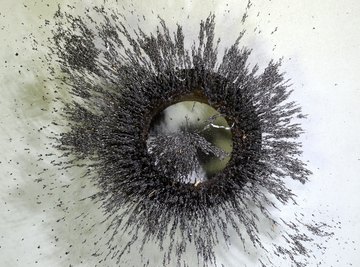
Most people know that iron is attracted to magnets, while other metals like gold and silver are not. Yet few people can explain exactly why iron has this magical relationship with magnetism. To arrive at the answer, you need to get down to the atomic level and examine the magnetic nature of an atom's electrons.
Electrons and Magnetism
The science behind magnetism, like electricity, comes down to electrons, the negatively charged particles surrounding an atom's nucleus. All electrons have magnetic properties, just as they have electrical properties. When an electron exhibits magnetism, and consequently, it's ability to interact with an external magnetic field, it's said to have a magnetic moment.
An electron's magnetic moment is based on its spin and its orbit, which are both principals of quantum mechanics. Without getting into quantum equations, suffice it to say that an electron's magnetic moment is due to its motion.
What Makes a Material Magnetic?
While the individual atoms in any substance can have magnetic moments, that doesn't mean the substance itself is magnetic. For the substance to be magnetic, you need a sufficient number of atoms all working together. This requires two things.
The first thing that needs to happen is that there must be some disagreement between the atoms. In many substances, all the electrons line themselves up in orderly pairs, each of them canceling out the magnetic properties of the other. If you imagine 1,000 locomotives, half of them trying to go north and the other half going south, none of them are going to move. So, for a substance to be magnetic, its electrons can't all be paired up.
However, this in itself isn't enough for the substance to be magnetic. Just because a material's electrons don't line up in pairs doesn't necessarily mean that the substance is magnetic. Manganese, for example, an important mineral found in nuts and cereals and essential for healthy bones, is not magnetic, even though its electrons don't line up in pairs. If you had 1001 train engines, 500 facing south and 501 facing north, that extra engine is not going to make much of a difference.
The second thing you need is for a sufficient number of electrons to align themselves parallel to each other – like a lot of locomotives facing in the same direction – so their ability to interact with an external magnetic field is substantial enough to move the entire object.
Any material that has these two conditions is called ferromagnetic. Iron is the most common ferromagnetic element. Two other ferromagnetic elements are nickel and cobalt. However, several other substances can be ferromagnetic when they are heated or combined with other materials.
References
About the Author
A published author and professional speaker, David Weedmark was formerly a computer science instructor at Algonquin College. He has a keen interest in science and technology and works as a technology consultant for small businesses and non-governmental organizations. A science fiction writer, David has also has written hundreds of articles on science and technology for newspapers, magazines and websites including Samsung, About.com and ItStillWorks.com
